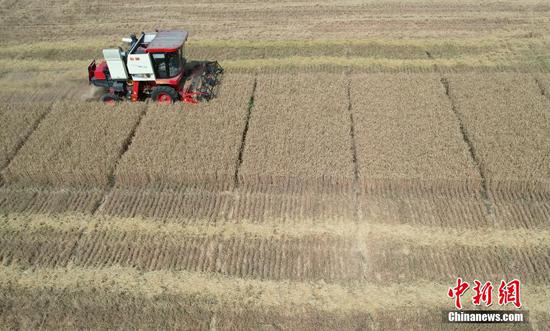An international team led by Chinese scientists discovered and located the first persistently active repeating fast radio burst (FRB) with the help of the world's largest radio telescope, China's Five-hundred-meter Aperture Spherical Radio Telescope (FAST), which indicated the evolution of FRBs and may help scientists understand the origin of the brightest radio waves emanating from billions of light years outside the galaxy.
The new FRB, named FRB190520B, was discovered in a metal-poor dwarf galaxy 3 billion light years away.
The initial discovery was made by Niu Chenhui, a research fellow from the National Astronomical Observatories of the Chinese Academy of Sciences (NAOC) through FAST from May 20, 2019. Then Law Casey, a scientist with the California Institute of Technology who led a Jansky Very Large Array (JVLA) program located the FRB190520B in July 2020.
The study led by chief scientist of FAST Li Di and titled "a repeating fast radio burst associated with a persistent radio source" was published in Nature on Wednesday.
FRBs are mysterious radio flashes lasting milliseconds from deep space, but little is known about their origin although some scientists suggest that they could be evidence of advanced alien life.
So far, less than 5 percent of all the hundreds of FRBs detected have been seen to repeat. Only a few are active and only the newly discovered FRB190520B is persistently active, thus providing precious glances into their secrets.
The FRB190520B has the highest ambient electron density of all FRBs and shows reliable bursting behaviors which can be detectable every month. Four bursts were detected during the initial 24 seconds.
The characteristics of FRB190520B indicated that it may be a "newborn." This discovery hints at an evolutionary picture of FRBs, according to the team.
Niu said FRB190520B is the first repeating FRB detected by FAST, and is only the second repeating FRB with a compact persistent radio source after discovery of the first repeater FRB121102A by US Arecibo Radio Telescope in 2016.
Niu told the Global Times that FRB190520B's behavior is similar to FRB121102A, but it's just more extreme as it is persistently active and has a more complex electromagnetic environment.
"We further postulate that FRB121102A and FRB190520B represent the initial stage of an evolving FRB population. A coherent picture of the origin and evolution of FRBs is likely to emerge in just a few years," said Li.
Duncan Lorimer, a professor at West Virginia University who discovered the first FRB, commented on the new finding of the FAST that it suggested the FRB phenomenon in general is likely due to a number of source populations, and further results that are anticipated in the coming years as the FRB sample continue to grow will allow us to elucidate the details of this intriguing population, according to NAOC.
Collaborative research is increasingly significant in astronomy and the location of FRB190520B was conducted with the help of American scientists and equipment despite US government's growing efforts in pushing for a technology and supply chain decoupling from China.
Li said that astronomy is a common pursuit of all mankind and FAST is used by international scientists from regions including the US, Europe and Australia.
At Monday's press conference, Hou Jianguo, president of the Chinese Academy of Sciences, said that so far FAST has provided observation time for 27 international projects from 14 countries.
After the initial posting of the new discovery, more in-depth analysis and modeling for this source have been published, including a polarization analysis, scattering timescale models and supernova origin models, NAOC said.


















































 京公網(wǎng)安備 11010202009201號
京公網(wǎng)安備 11010202009201號